Wilding the Backyard Lawn
Swapping out the expansive lawns for other types of gardening projects takes hard work, patience, and a fine-tuning of expectations.
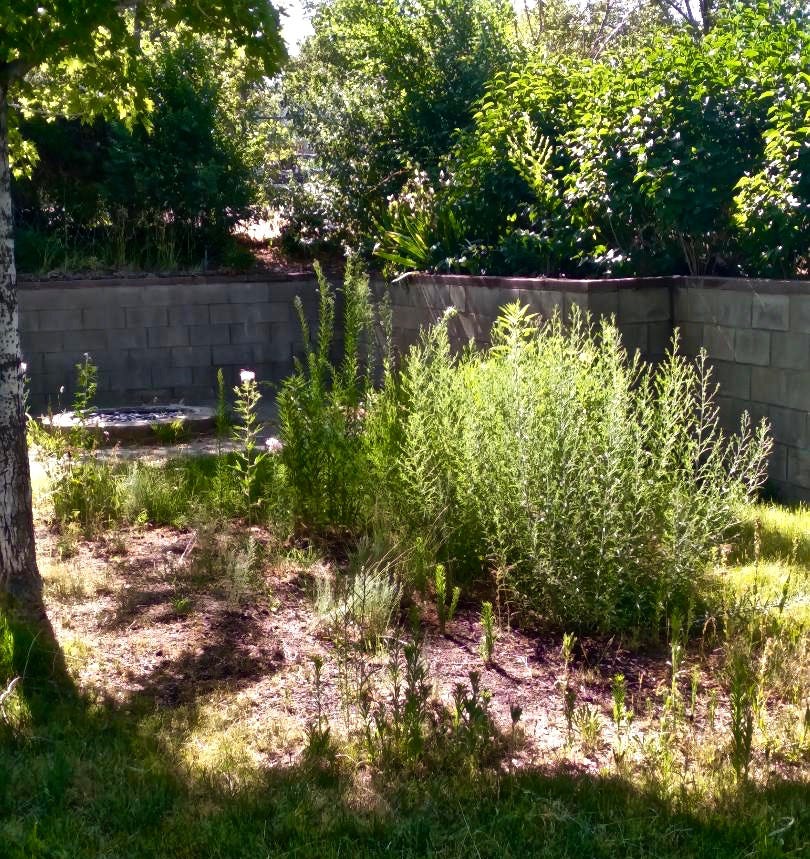
When we bought our home in Minden, NV, most of the acre was landscaped with beautiful manicured lawns. Apparently, the former owner's hobby was mowing the grass on weekends. Jeff made a valiant effort to keep it up to previous standard. Then he bailed.
"I've got better things to do with my time. And the water usage is ridiculous."
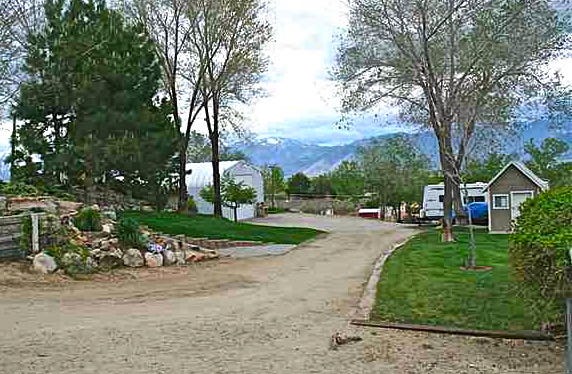
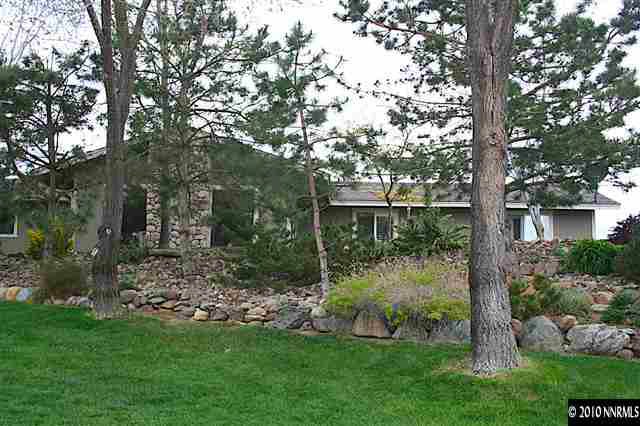
I appreciated his concerns and plans for other projects with the land and realized I couldn't maintain this pristine property in its pre-sale condition. The wind gifted us with varieties of weeds and removing them became MY hobby, and the bane of my joints. Jeff mowed the walled backyard as a compromise until the sprinkler system left gaping barrens here and there. So, morphing this landscape into something more physically and economically affordable as well as beneficial for our wild neighbors became our goal.
As Jeff developed his potato, garlic, and onion patches, I literally busted my buttocks pulling the volunteers. I tried following my Truckee neighbor's method of selective weeding - purging the "wildflowers" I didn't like and allowing the preferred ones to flourish.
Of course, every May, we spent hundreds of dollars on nursery plants, murdering most of them until we discovered ones that took root in our begrudging Nevada soils. We also amended those soils with tons of manure and potting mixes. The gardens have rewarded us with a rich sandy loam. The potatoes et al are spectacular. And lavender and snapdragons soldier on through withering heat and dry, freezing winters. And finally, I found a source for petunia flats with healthy plants already in their second blooming.
For the past couple of years, we've succeeded with planting wildflowers and daffodil bulbs in the backyard lawn. Then we sowed the "bean" garden, named for its shape, and the bare spots in the grass with bags of wildflower seeds courtesy of online vendors. Serendipity smiled upon our efforts and here are the results:

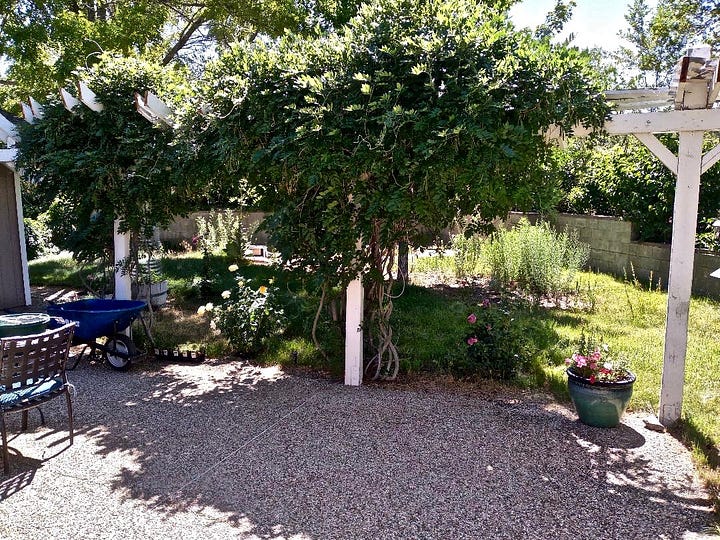
This is the before and after result of Jeff's mowing the backyard and letting it go wild. Quite the jungle, don't you think? There's an adjustment in aesthetics involved in this process. Those pretty pictures in the garden magazines and online articles are nothing like the random and rampant growth happening in our yard this year. (That pergola roof collapsed under heavy snows one year, granting us the joy of seeing the wisteria blooms. For years, birds nested in this. Now we get to enjoy the flowers. I hope the birds will return to nesting.)
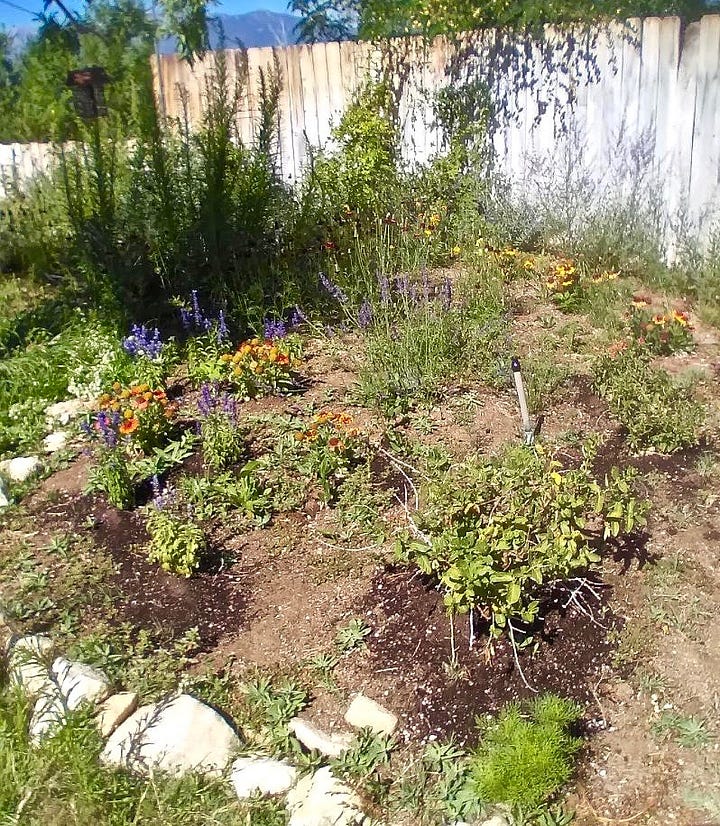
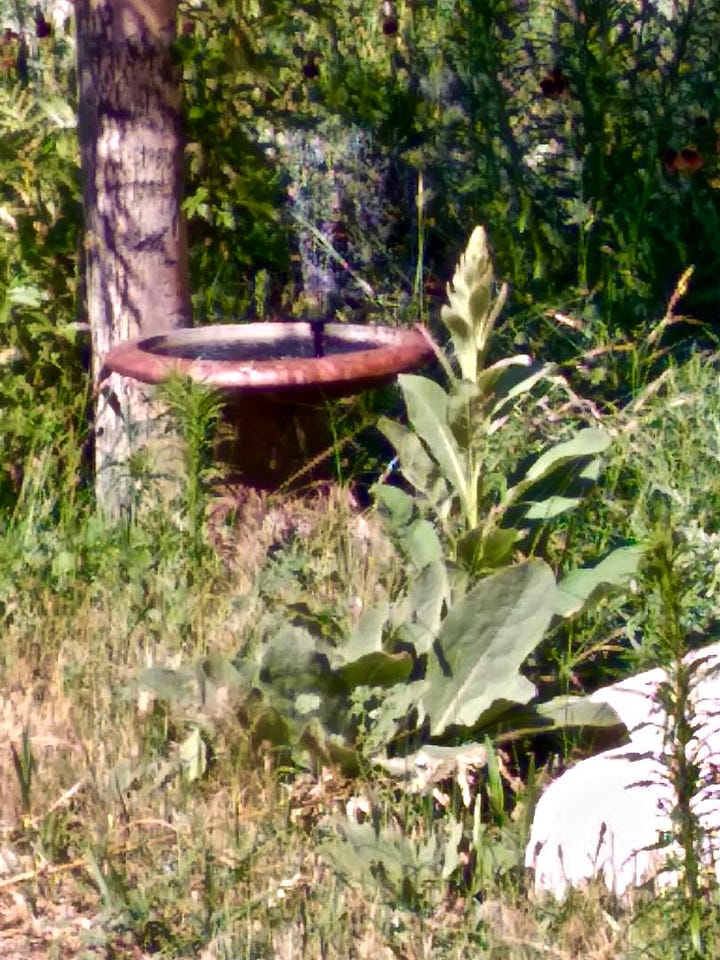
We're trying to learn what all these wildflowers are as they burst forth. Left: a combination of wildflowers and nursery blanket flowers and snapdragons. Right: a $35 solar fountain keeps the water cool. The birds just have to get used to what it is. That triffid in front is a mullein, a good source of tea for your bronchial maladies as well as winter food for the birds.
We’ve thrown around so much seed that we don't know what this is. What came in the bag also blends with the gifts from the Afternoon Zephyr. We're wondering what this mass of tall, aggressive flowers will be. I'm losing patience awaiting their blossoming. Maybe it's amaranth. Anybody know? That’s lavender peeking up through this stuff.
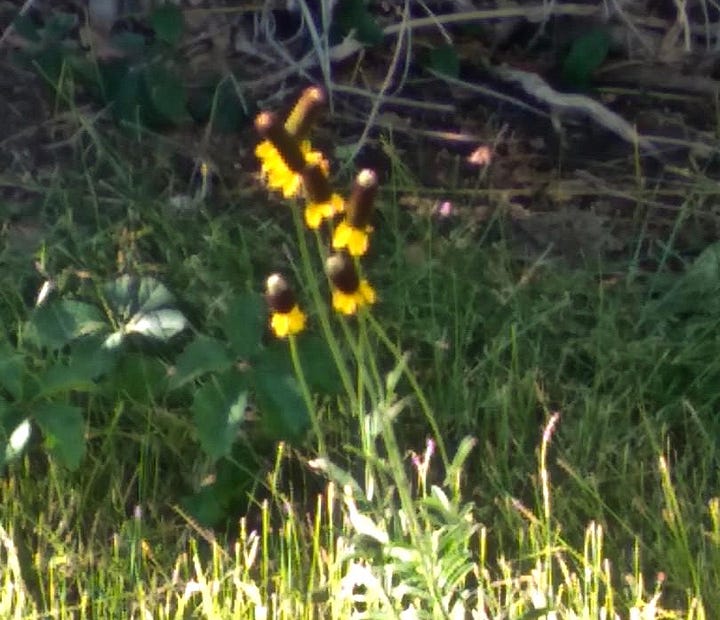

Various flowers that have surprised and pleased us. Hopefully they will reseed and take over the garden. They seem to be happy with this environment. What's so much fun about this process is seeing all the mysterious things that appear. Yeah, I should know what these are named, but maybe I need to stop "shoulding" all over myself.
I couldn't resist this glorious piece of tacky garden art. Aragon is his name. Those petunias in the container were the slow bloomers, but finally they're showing some gumption. Those are nursery succulents and a border of some cool-looking weeds he’s guarding behind him. The weeds have this head that opens into an ethereal “bloom” that sparkles in the sunlight. Delicate and delightful.
These fuzzy photos were taken on July 2, 2025. I've read that developing a wildflower garden takes at least three years to reach full blooming potential. This is the third year and things are going gonzo around here. I don't know whether we just got more reliable seed or what. And I don't care. Just seeing all these surprises bursting forth from the earth is giving me a major buzz.
Of course, I've had to learn the hard lesson that every garden has a life cycle. Like every story, it has a beginning, a middle, and an end. When all of this wild magnificence dies back in October, how do we prune, pick, and clear away to put the garden to bed? Plants with seed heads will be left to feed the birds over winter. Dead foliage will become mulch for the creepy-crawlies, but dried stalks and other debris will earn a ride to the dump to become mulch for public gardens.
I hope this has inspired some of my readers to try this. It's an interesting experiment in devotion to goal, patience, and fine-tuning one's expectations according to the conditions of micro-climates, soil conditions, and general environment. Whew!
If you enjoyed this post, feel free to explore other writings in the Ring Around the Basin Archive. I also love to read your comments, so please share your thoughts. Let’s start a conversation. And if you wish to support my writings, please consider subscribing or upgrading to a paid subscription. It’s now only $50/year. Even better, I would appreciate it if you could share Ring Around the Basin with your friends. Thank you!





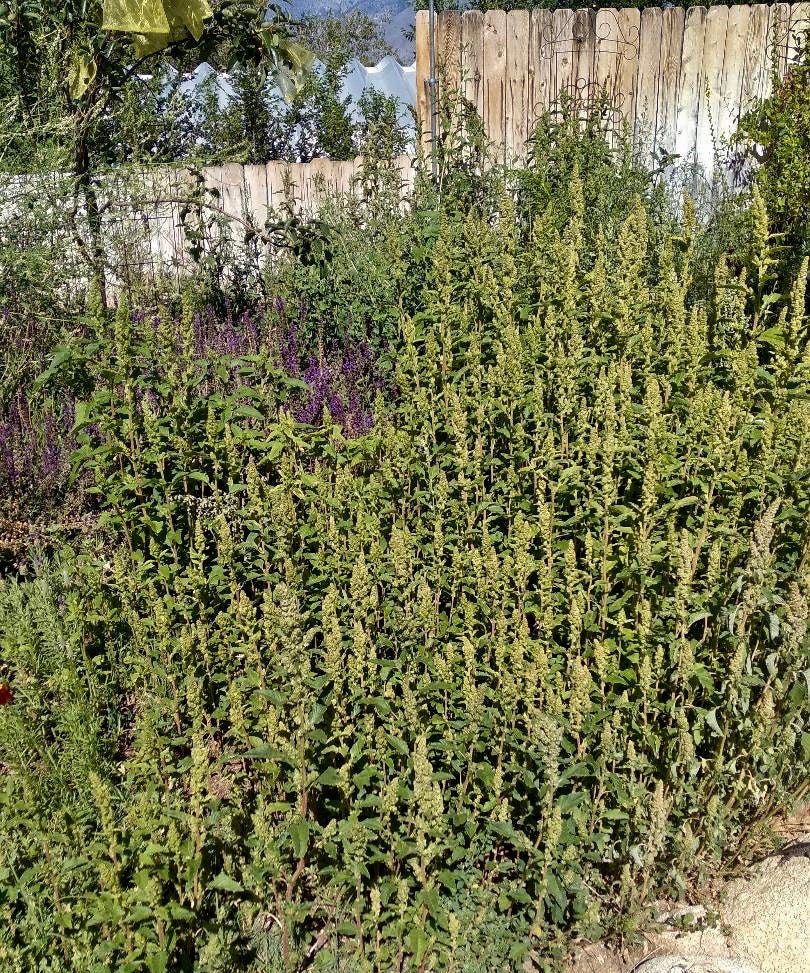
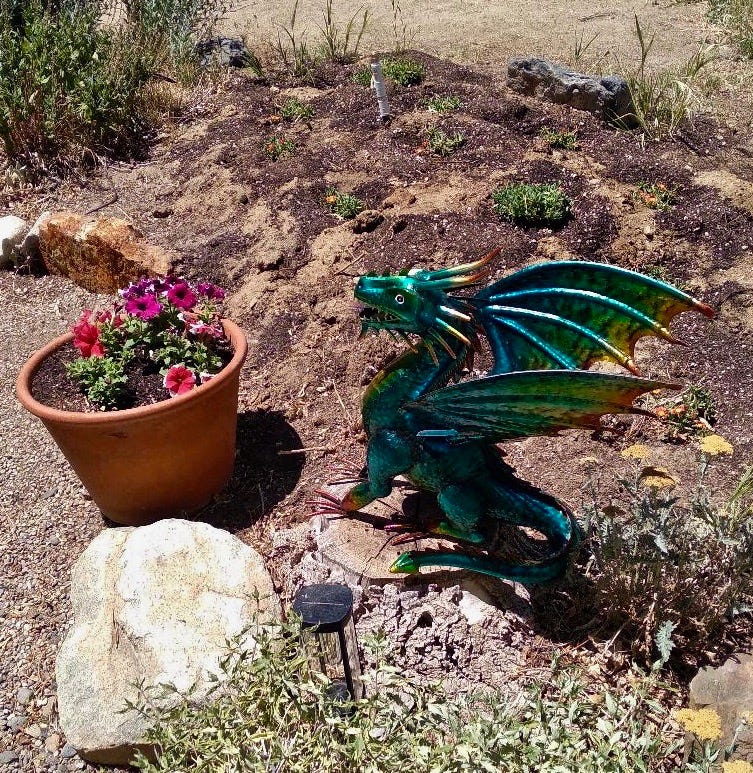

Good job. I'm tired from just reading about it.
You have done a beautiful job here, Sue. And I know how much time and physical work it takes. The surprise element is just delightful. Instead of researching the names of the wildflowers, I would more likely just give them new names. Anything I like! ("pink babies", "flirty girls", "red spikes" ) By the way, have you tried ivy geraniums? Specifically the ivy variety, not the standard thick-stalked ones? They are actually a desert plant and don't require much water. Here they are perennials, staying green all year with two, sometimes three, blooming events per year. Irises might be sturdy enough as perennials, too? Just lovely. Thanks for the great photos.